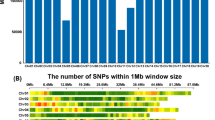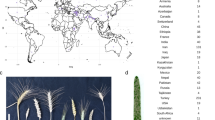Abstract
Wild relatives of barley disperse their seeds at maturity by means of their brittle rachis. In cultivated barley, brittleness of the rachis was lost during domestication. Nonbrittle rachis of occidental barley lines is controlled by a single gene (btr1) on chromosome 3H. However, nonbrittle rachis of oriental barley lines is controlled by a major gene (btr2) on chromosome 3H and two quantitative trait loci on chromosomes 5HL and 7H. This result suggests multiple mutations of the genes involved in the formation of brittle rachis in oriental lines. The btr1 and btr2 loci did not recombine in the mapping population analyzed. This result agrees with the theory of tight linkage between the two loci. A high-density amplified fragment-length polymorphism (AFLP) map of the btr1/btr2 region was constructed, providing an average density of 0.08 cM/locus. A phylogenetic tree based on the AFLPs showed clear separation of occidental and oriental barley lines. Thus, barley consists of at least two lineages as far as revealed by molecular markers linked to nonbrittle rachis genes.




Similar content being viewed by others
References
Åberg E (1938) Hordeum agriocrithon nova sp., a wild six-rowed barley. Ann Agric Coll Sweden 6:159–216
Badr A, Müller K, Schäfer-Pregl R, El Rabey H, Effgen S, Ibrahim H, Pozzi C, Rohde W, Salamini F (2000) On the origin and domestication history of barley (Hordeum vulgare). Mol Biol Evol 17:499–510
Basten C, Weir B, Zeng Z-B (2000) QTL Cartographer 1.14. A reference manual and tutorial for QTL mapping. Department of Statistics, North Carolina State University, Raleigh
Bothmer Rv (1979) Revision of the Asiatic taxa of Hordeum sect. Stenostachys. Bot Tidsskr 74:117–147
Bothmer Rv, Jacobsen N (1985) Origin, taxonomy, and related species. In: Rasmusson D (ed) Barley—ASA agronomy monograph, vol 26. American Society of Agronomy, Crop Science Society of America, Soil Science Society of America, Madison, pp 19–56
Bothmer Rv, Jacobsen N, Baden C, Jørgensen R, Linde-Laursen I (1995) An ecogeographical study of the genus Hordeum, 2nd edn. Systematic and ecogeographic studies on crop genepools. 7. International Plant Genetic Resources Institute, Rome
Cai H-W, Morishima H (2000) Genomic regions affecting seed shattering and seed dormancy in rice. Theor Appl Genet 100:840–846
Castiglioni P, Pozzi C, Heun M, Terzi V, Müller K, Rohde W, Salamini F (1998) An AFLP-based procedure for the efficient mapping of mutations and DNA probes in barley. Genetics 149:2039–2056
Eiguchi M, Sano Y (1990) A gene complex responsible for seed shattering and panicle spreading found in common wild rices. Rice Genet Newsl 7:105–107
Elliott W, Perlinger G (1977) Inheritance of shattering in wild rice. Crop Sci 17:851–853
Franckowiak J, Lundqvist U, Konishi T (1997) New and revised names for barley genes. Barley Genet Newsl 26:4–8
Frederiksen S, Petersen G (1998) A taxonomic revision of Secale (Triticeae, Poaceae). Nordic J Bot 18:399–420
Freisleben R (1943) Ein neuer Fund von Hodeum agriocrithon Åberg. Zuchter 15:25–29
Fukuta Y (1995) Genetic analysis of shattering-resistance mutant lines induced from an indica rice variety, ‘Nan-jing 11.4’. RFLP mapping of a mutant gene in ‘Hokuriku 143’ (SR-5). Breed Sci 45 [Suppl 1]:89
Fukuta Y, Harushima Y, Yano M (1996) Using quantitative trait locus analysis for studying genetic regulation of shattering. Rice Genet 3:657–662
Johnson I, Åberg E (1943) The inheritance of brittle rachis in barley. J Am Soc Agron 35:101–106
Kandemir N, Kudrna D, Ullrich S, Kleinhofs A (2000) Molecular marker-assisted genetic analysis of head shattering in six-rowed barley. Theor Appl Genet 101:203–210
Kennard W, Phillips R, Porter R (2002) Genetic dissection of seed shattering, agronomic, and color traits in American wild rice (Zizania palustris var. interior L.) with a comparative map. Theor Appl Genet 105:1075–1086
Kimber G, Feldman M (1987) Wild wheat. An introduction. College of Agriculture, University of Missouri, Columbia
Komatsuda T, Mano Y (2002) Molecular mapping of the intermedium spike-c (int-c) and non-brittle rachis 1 (btr1) loci in barley (Hordeum vulgare L.). Theor Appl Genet 105:85–90
Komatsuda T, Annaka T, Oka S (1993) Genetic mapping of a quantitative trait locus (QTL) that enhances the shoot differentiation rate in Hordeum vulgare L. Theor Appl Genet 86:713–720
Konishi T (2001) Genetic diversity in Hordeum agriocrithon E. Aberg, six-rowed barley with brittle rachis, from Tibet. Genet Resource Crop Evol 48:27–34
Lander E, Green P, Abrahamson J, Barlow A, Daly M, Lincoln S, Newburg L (1987) MAPMAKER: an interactive computer package for constructing primary genetic linkage maps of experimental and natural populations. Genomics 1:174–181
Lincoln S, Daly M, Lander E (1993) Constructing genetic linkage maps with MAPMAKER/Exp 3.0. Whitehead Institute for Biomedical Research Technical Report, 3rd edn. Cambridge
Linde-Laursen I, Heslop-Harrison J, Shepherd K, Taketa S (1997) The barley genome and its relationship with the wheat genomes. A survey with an internationally agreed recommendation for barley chromosome nomenclature. Hereditas 126:1–16
Lundqvist U, Franckowiak JD, Konishi T (1997) New and revised descriptions of barley genes. Barley Genet Newsl 26:22–516
Mano Y, Komatsuda T (2002) Identification of QTLs controlling tissue-culture traits in barley (Hordeum vulgare L.). Theor Appl Genet 105:708–715
Mano Y, Kawasaki S, Takaiwa F, Komatsuda T (2001) Construction of a genetic map of barley (Hordeum vulgare L.) cross ‘Azumamugi’ × ‘Kanto Nakate Gold’ using a simple and efficient amplified fragment-length polymorphism system. Genome 44:284–292
Molina-Cano J, Gómèz-Campo C, Conde J (1982) Hordeum spontaneum C. Koch as a weed of barley fields in Morocco. Z Pflanzenzuecht 88:161–167
Molina-Cano J, Moralejo M, Igartua E, Romagosa I (1999) Further evidence supporting Morocco as a centre of origin of barley. Theor Appl Genet 98:913–918
Nei M, Kumar S (2000) Molecular evolution and phylogenetics. Oxford University Press, New York
Oba S, Kikuchi F, Maruyama K (1990) Genetic analysis of semidwarfness and grain shattering of Chinese rice variety ‘Ai-Jio-Nan-Te’. Jpn J Breed 40:13–20
Paterson A, Lin Y-R, Li Z, Schertz K, Doebley J, Pinson S, Liu S-C, Stansel J, Irvine J (1995) Convergent domestication of cereal crops by independent mutations at corresponding genetic loci. Science 269:1714–1718
Sameri M, Komatsuda T (2004) Identification of quantitative trait loci controlling morphological and physiological traits, which are characteristic between Oriental and Occidental barley cultivars (Hordeum vulgare L.). Spunar I, Janicoba J (eds) Proceedings of 9th International Barley Genetics Symposium, Brno, Czech Republic, 20–26 June 2004, pp 231–236
Sanchez P, Kurakazu T, Hirata C, Sobrizal A, Yoshimura A (2002) Mapping of seed shattering genes using introgression lines from wild species of rice. Breed Res 4:68
Schiemann E (1921) Genetische Studien an Gerste. Z Indukt Abstammungs Vererbungsl 26:109–143
Slageren M van (1994) Wild wheats: a monograph of Aegilops L. and Amblyopyrum (Jaub. & Spach) Eig (Poaceae). Wageningen Agriculture University, Wageningen
Swofford D (1998) PAUP*. Phylogenetic analysis using parsimony (*and other methods), ver 4. Sinauer, Sunderland, Mass.
Takahashi R (1942) Studies on the classification and the geographical distribution of the Japanese barley varieties. I. Significance of the bimodal curve of the coleoptile length. Ber Ohara Inst Landwirtsch Biol Okayama Univ 9:71–90
Takahashi R (1951) Studies on the classification and the geographical distribution of the Japanese barley varieties. II. Correlative inheritance of some quantitative characters with the ear types. Ber Ohara Inst Landwirtsch Biol Okayama Univ 9:383–398
Takahashi R (1955) The origin and evolution of cultivated barley. In: Demerec M (ed) Advances in Genetics, vol 7. Academic, New York, pp 227–266
Takahashi R (1963) Further studies on the phylogenetic differentiation of cultivated barley. Barley Genet 1:19–26
Takahashi R, Hayashi J (1959) Linkage study of the genes for brittle rachises in barley (preliminary) (in Japanese). Nogaku Kenkyu 46:113–119
Takahashi R, Hayashi J (1964) Linkage study of two complementary genes for brittle rachis in barley. Ber Ohara Inst Landwirtsch Biol Okayama Univ 12:99–105
Takahashi R, Yamamoto J (1949) Studies on the classification and the geographic distribution of barley varieties. 8. Nogaku Kenkyu 38:41–43
Takahashi R, Yamamoto J (1951) Studies on the classification and the geographic distribution of barley varieties. 15. Nogaku Kenkyu 39:81–90
Takahashi R, Hayashi J, Moriya I (1979) Geographical differentiation of the genes for compact head barley. Barley Genet Newsl 9:99–101
Takahashi R, Yasuda S, Hayashi J, Fukuyama T, Moriya I, Konishi T (1983) Catalogue of barley germplasm preserved in Okayama University. Okayama University, Kurashiki
Tanno K (1999) Molecular phylogeny in the genus Hordeum. PhD Thesis, University of Tsukuba
Tanno K, Takaiwa F, Oka S, Komatsuda T (1999) A nucleotide sequence linked to the vrs1 locus for studies of differentiation in cultivated barley (Hordeum vulgare L.). Hereditas 130:77–82
Tanno K, Taketa S, Takeda K, Komatsuda T (2002) A DNA marker closely linked to the vrs1 locus (row-type gene) indicates multiple origins of six-rowed cultivated barley (Hordeum vulgare L.). Theor Appl Genet 104:54–60
Ubisch Gv (1915) Analyse eines Falles von Bastardatavismus und Faktorenkoppelung bei Gerste. Z Indukt Abstammungs Vererbungsl 14:226–237
Vos P, Hogers R, Bleeker M, Reijans M, van de Lee T, Hornes M, Frijters A, Pot J, Peleman J, Kuiper M, Zabeau M (1995) AFLP: a new technique for DNA fingerprinting. Nucleic Acids Res 23:4407–4414
Watanabe N, Ikebata N (2000) The effects of homoeologous group 3 chromosomes on grain colour dependent seed dormancy and brittle rachis in tetraploid wheat. Euphytica 115:215–220
Zohary D, Hopf M (2000) Domestication of plants in the old world. Oxford, New York
Acknowledgements
We thank Dr. T. Konishi (Okayama, Japan) and Drs. K. Takeda and Dr. K. Sato (Okayama University, Kurashiki, Japan) for critically reviewing the manuscript; Dr. A. Paterson (University of Georgia, USA) for comments on the manuscript; Dr. R. von Bothmer (Swedish University of Agricultural Sciences), Dr. B. Salomon (Swedish University of Agricultural Sciences), Dr. B. Gill (Kansas State University, USA), Dr. Y. Ogihara (Yokohama City University, Japan), and Dr. N. Minaka (National Institute of Agro-Environmental Sciences, Tsukuba, Japan) for discussions; and Dr. B. E. Sayed-Tabatabaei (Isfahan University of Technology, Iran) for helping in AFLP analysis. Research grants from Core Research for Evolutional Science and Technology (CREST), Japan Science and Technology Corporation to T. Komatsuda are gratefully appreciated. P. Maxim and N. Senthil are STA fellows, and Y. Mano is a research fellow, all supported by JST.
Author information
Authors and Affiliations
Corresponding author
Additional information
Communicated by J.S. Heslop-Harrison
An erratum to this article can be found at http://dx.doi.org/10.1007/s00122-004-1864-9
Electronic Supplementary Material
Rights and permissions
About this article
Cite this article
Komatsuda, T., Maxim, P., Senthil, N. et al. High-density AFLP map of nonbrittle rachis 1 (btr1) and 2 (btr2) genes in barley (Hordeum vulgare L.). Theor Appl Genet 109, 986–995 (2004). https://doi.org/10.1007/s00122-004-1710-0
Received:
Accepted:
Published:
Issue Date:
DOI: https://doi.org/10.1007/s00122-004-1710-0




